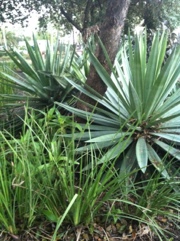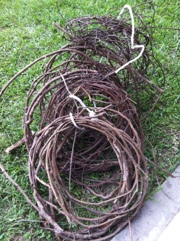So who has ever wondered what plants are good for weaving? I know I have!
That pondering set me off on a journey – what plants grow in my garden, and in those around me, that are good to harvest and prepare, ready to be transformed into an amazing expression of soul…?
Many explorations and experimentations and conversations later, I have come up with an evolving list of plants that grow on the Sunshine Coast. Some are native, some are exotic, some are traditional and some are actually weeds that need eradication! I don’t believe that it’s crucial to know the names of the plants we use, better to learn the properties of suitable plants and then adapt and experiment wherever we go – that way our knowledge won’t be restricted by where we are, just by our imagination and willingness to discover the treasures that grow wherever we are in the world. Saying that, however, it does help in the sharing of knowledge, to be able to name a plant to enable further investigation.
This is the space that I will use as my platform to share my plantery journey – an initial plant list and an ongoing blog about what new weaving and dye fibres I have found in my travels around the coast, and how to harvest, prepare and use them. I hope you enjoy my journey as much as I do.
Baumea Rubiginosa
Below is an initial list of plants with fibre suitable for weaving applications, more details and variety can be found in blog category ‘The A – Z of weaving plant fibres’.
Palms: Inflorescence, bracts and leaf sheaths of Piccabeen, Alexandra and other palm varieties.
Raffia, Raphia farinifera Fibrous inner matter of the palm fronds.
Banana leaf sheaths, Musa acuminata, Musa balbisiana
Coconut husk and leaf, Cocos nucifera
Yukka leaf fibres, Asparagaceae, subfamily Agavoideae
Ponytail Palm leaves, Beaucarnea recurvata (Mexico)
Cabbage tree leaves, Cordyline Australis, (NZ)
It provided durable fibre for textiles, anchor ropes, fishing lines, baskets, waterproof rain capes and cloaks, and sandals.
Daylily leaves, Hemerocallis, (North America, South America, Caribbean)
New Zealand Flax leaf fibre, Phormium tenax and Phormium cookianum, (NZ)
Couch grass, Elymus repens
Philodendron leaf sheaths, Philodendron bipinnatifidum, (South America)
Red Hot Poker leaves, Kniphofia uvaria, (Cape Province, South Africa)
Norfolk pine needles, Araucaria heterophylla, (Norfolk Island, Pacific)
English Lavender stems, Lamiaceae, (Asia)
Sweet Corn sheaths, Family: Poaceae Subfamily: Panicoideae
Jackaranda leaf stems, Bignoniaceae, (South America, Central America, Mexico)
Weed vines:
“Archie”, Archer Axilaris
Morning Glory, Convolvulaceae
Dutchman’s pipe, Aristolochiaceae
Cat’s claw creeper, Macfadyena unguis-cati
NATIVES
Piccabeen palm, Archontophoenix cunninghamiana
Screw pine leaves, Pandanus Tectorius
Mat rush leaves, Lomandra longifolia
Flax Lily leaves, Dianella Longifolia
Swamp paperbark, Melaleuca Ericifolia
Eucalyptus stems
Kangaroo paw, Anigozanthos
Bulrush or cumbungi, Typha species
River club-rush – Schoenoplestus Validus
Tall spike-rush – Eleocharis sphacelata
Pale rush – Juncus Pallidus
Dodder, Cuscuta
Lawyer cane, Calamus Australis




